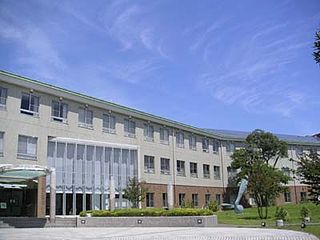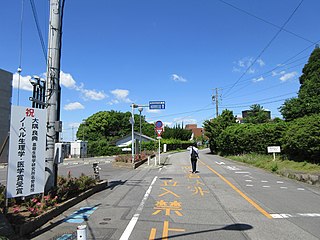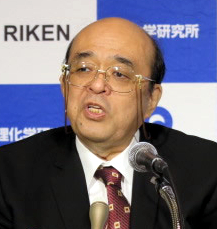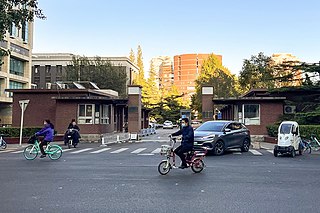
The University of Tokyo is a public research university in Bunkyō, Tokyo, Japan. Founded in 1877 by the merger of several pre-westernisation era institutions such as the Shoheizaka Institute and Kaiseijo, it is the nation's oldest modern university.
Ritsumeikan University is a private university in Kyoto, Japan, that traces its origin to 1869. In addition to its main campus in Kyoto, the university also has satellite campuses in Ibaraki, Osaka and Kusatsu, Shiga.

Nagoya University, abbreviated to Meidai (名大) or NU, is a Japanese national research university located in Chikusa-ku, Nagoya. It was the seventh Imperial University in Japan, one of the first five Designated National University and selected as a Top Type university of Top Global University Project by the Japanese government. It is the 3rd highest ranked higher education institution in Japan.

Tsuneko Okazaki is a Japanese pioneer of molecular biology known for her work on DNA replication and specifically for discovering Okazaki fragments, along with her husband Reiji. Dr. Tsuneko Okazaki has continued to be involved in academia, contributing to more advancements in DNA research.

The Institute of Medical Science is an ancillary establishment of Tokyo University. It succeeded the Institute of Infectious Diseases established in 1892 and is the foremost institute for medical and bioscience research in Japan.

Kanazawa University is a Japanese national university in the city of Kanazawa, the capital of Ishikawa Prefecture. Founded in 1862, it was chartered as a university in 1949.

The Japan Atomic Energy Agency is an Independent Administrative Institution formed on October 1, 2005 by a merger of two previous semi-governmental organizations. While it inherited the activities of both JNC and JAERI, it also inherited the nickname of JAERI, "Genken" 原研, an abbreviated word for "nuclear research".

The Graduate University for Advanced Studies, SOKENDAI is one of the national universities of Japan, headquartered in Shonan Village (湘南国際村) in the town of Hayama in Kanagawa Prefecture. Sōkendai (総研大), as it is generally called in its abbreviated form, was established in 1988, with Dr. Saburo Nagakura as its president. SOKENDAI is the first national university in Japan having offered exclusively graduate programs. Graduate students are trained at affiliated research institutes distributed around Japan and the world. It has both five-year doctoral programs for students with a bachelor's degree and three-year programs for those with a master's degree.

Taipei Japanese School (TJS) is a Japanese international school located in Shilin District, Taipei. TJS was established in 1947 and mainly serves the children of Japanese expatriates in Taiwan.
The National Institute of Natural Sciences (NINS) is an inter-university research institute corporation consisting of five member institutes: the National Astronomical Observatory (NAOJ), the National Institute for fusion Science (NIFS), the National Institute for Basic Biology (NIBB), the National Institute for Physiological Sciences (NIPS), and the Institutes for Molecular Sciences (IMS). NINS was established in April 2004 to bring about further development of the natural sciences in Japan.
Wenying Zhuang is a Chinese mycologist. She is known for her contributions to the study of species diversity and phylogeny of Ascomycetes.

Kazutoshi Mori is a Japanese molecular biologist known for research on unfolded protein response. He is a professor of Biophysics at the Graduate School of Science, Kyoto University, and shared the 2014 Albert Lasker Basic Medical Research Award with Peter Walter for discoveries concerning the unfolded protein response — an intracellular quality control system that detects harmful misfolded proteins in the endoplasmic reticulum and signals the nucleus to carry out corrective measures.

The National Institute for Physiological Sciences (NIPS) is an inter-university research institute and part of the National Institute of Natural Sciences, located in the city of Okazaki, Aichi, Japan. It was established in 2004.

Kōsuke Morita is a Japanese experimental nuclear physicist, known as the leader of the Japanese team that discovered nihonium. He currently holds a joint appointment as a professor at Kyushu University’s Graduate School of Science and as director of the Super Heavy Element Research Group at Riken's Nishina Center for Accelerator-Based Science.

The Institute of Physicsof the Chinese Academy of Sciences was the result of a merger, after the communist took control of the mainland China in 1949, between the Institute of Physics of Academia Sinica (IOPAS) founded in Shanghai in 1928 and the Institute of Physics of National Academy of Peiping (IOPNAP) founded in Beiping in 1929. The director of the IOPNAP, physicist Yan Jici, was appointed director of the new institution after the merger was completed in 1950. The new entity was named the Institute of Applied Physics before being renamed to Institute of Physics in 1958. In Taiwan, the IOPAS was re-established in Taipei in 1962 by another "founding father" of modern Chinese physics - Wu Ta-You.
Osaka Metropolitan University, abbreviated to OMU, is a Japanese public university that was established through the integration of Osaka City University (OCU) and Osaka Prefecture University (OPU) on 1 April 2022.
In 2010s, a series of separate allegations of scientific misconducts were raised involving several scientific papers from various Japanese universities.

The Office of Japanese Classics Research was a central government organization for the training of the Shinto priesthood in Japan. It was established by the Meiji Government in 1882 as the successor organization to the Bureau of Shinto Affairs. Prince Arisugawa Takahito was its first leader.

Graduate School of Medicine and Faculty of Medicine (京都大学大学院医学研究科・医学部) is one of the schools at the Kyoto University. The Faculty and the Graduate School operate as one.














